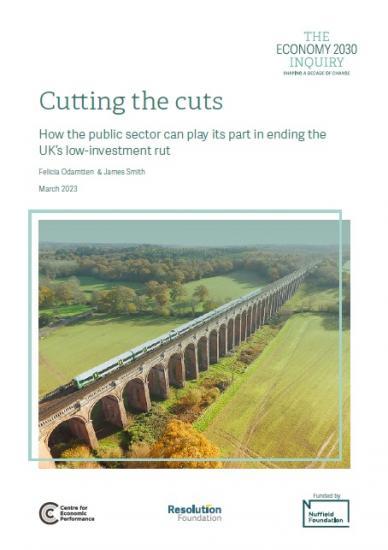Cutting The Cuts How The Public Sector Can Play Its Part In Ending The Uk's Low-investment Rut
1st April 2023

A history of weak and highly volatile public investment has contributed to Britain becoming a low investment nation, leaving us poorer and affecting people's everyday lives. This is the result of repeated policy failings that require radical reforms so that public investment can be used to boost growth and meeting the challenges of the decade ahead. This briefing note - part of the Economy 2030 Inquiry, funded by the Nuffield Foundation - set out the reasons for such policy failure, the implications of getting it wrong, and how we should reform the way we do policy in this area.
Public investment has not just been too low, it has also been too volatile with frequent, large changes in investment spending plans. This leads to underspends as investment takes time to ramp up and financing managers are reticent to commit long-term funds. A key reason for this volatility is strong political and fiscal incentives to cut public investment when the public finances are under pressure.
While the Government to its credit planned to increase investment after the 2019 General Election, raising it to levels not sustained since the 1970s, it has been cut just two years later in the wake of Liz Truss' mini-budget, reversing more than 80 per cent of the gains that had been planned.
Key Findings
Britain is an international laggard when it comes to public investment - consistently featuring in the weakest third of OECD countries. Had the UK's levels been at the OECD average over the past two decades, public investment would have been a truly transformational £500 billion higher (in 2022 prices).
The failure to provide consistent funding for our transport, housing, healthcare and local services has clear consequences in our day-to-day lives: it lies behind the fact that we have fewer hospital beds per person than all bar one OECD advanced country, and spend more time commuting than all bar two.
The UK having the most volatile annual growth rate among all OECD advanced economies apart from one. This volatility hampers efforts to deliver investments - with the government on average failing to spend around £1 in every £6 it plans to.
Public investment has been cut by an average of nearly 20 per cent in each of the post-recession fiscal consolidations that have taken place since the 1970s.
Policy recommendations
The fiscal rules should be changed to stop ‘feast and famine' in public investment by taking more account of the difference between investment and day-to-day spending, reducing incentives for short-termist politicians to cut investment when bad news comes along.
But more radical institutional change may be needed. This could include legislation to take decisions about public investment levels out of the Treasury altogether, setting public investment through an Act at the start of each parliament. This would raise the bar for using cuts to public investment for the purposes of fiscal fine tuning.
The Treasury instead should focus on improving the quality of public investment, by ensuring greater transparency over the business case for particular projects, and setting longer-term budgets for departments, or strategic infrastructure projects such as HS2. And more investment decisions should also be devolved outside of Whitehall.
Read the full report HERE
Pdf 31 Pages
